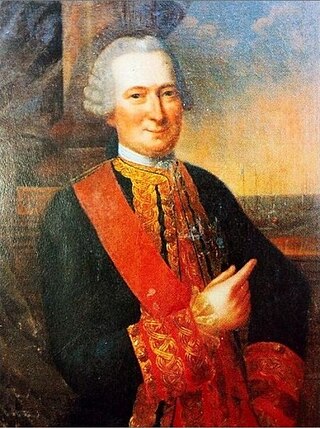Related Research Articles

Méduse was a 40-gun Pallas-class frigate of the French Navy, launched in 1810. She took part in the Napoleonic Wars during the late stages of the Mauritius campaign of 1809–1811 and in raids in the Caribbean.

The Raft of the Medusa – originally titled Scène de Naufrage – is an oil painting of 1818–19 by the French Romantic painter and lithographer Théodore Géricault (1791–1824). Completed when the artist was 27, the work has become an icon of French Romanticism. At 491 by 716 cm, it is an over-life-size painting that depicts a moment from the aftermath of the wreck of the French naval frigate Méduse, which ran aground off the coast of today's Mauritania on 2 July 1816. On 5 July 1816, at least 147 people were set adrift on a hurriedly constructed raft; all but 15 died in the 13 days before their rescue, and those who survived endured starvation and dehydration and practiced cannibalism. The event became an international scandal, in part because its cause was widely attributed to the incompetence of the French captain.

Auguste René Caillié was a French explorer and the first European to return alive from the town of Timbuktu. Caillié had been preceded at Timbuktu by a British officer, Major Gordon Laing, who was murdered in September 1826 on leaving the city. Caillié was therefore the first to return alive.

Sokhna Benga (Mbengue) is a Senegalese novelist and poet. She writes in French.

The Bay of Arguin is a bay on the Atlantic shore of Mauritania and the former mouth of the Tamanrasset River, now a Paleo-river.
Le Radeau de la Méduse is a French film by Iranian film director Iradj Azimi. It is based on the 1816 wreck of the French frigate Méduse, and the 1819 painting Le Radeau de la Méduse by Jean-Louis André Théodore Géricault which depicts the event. Filming began in 1987, but was interrupted by Hurricane Hugo in September 1989, which delayed completion of the film until the following year. Distribution of film then languished for several years, until Azimi cut his wrist in front of officials of the French Ministry of Culture.

Louis Guillouet, comte d'Orvilliers was a French admiral.

Charlotte Aglaé d'Orléans was Duchess of Modena and Reggio by marriage to Francesco III d'Este. She was the third daughter of Philippe II, Duke of Orléans and his wife, Françoise-Marie de Bourbon. She was born a princesse du sang, and had ten children, including Ercole III d'Este, Duke of Modena.

Surveillante was an Iphigénie-class 32-gun frigate of the French Navy. She took part in the Naval operations in the American Revolutionary War, where she became famous for her battle with HMS Quebec; in 1783, she brought the news that the war was over to America. She later took part in the French Revolutionary Wars, and was eventually scuttled during the Expédition d'Irlande after sustaining severe damage in a storm. The wreck was found in 1979 and is now a memorial.

Pierre-François-Henri-Étienne Bouvet de Maisonneuve was a French Navy officer and privateer.
Colonel Julien-Désiré Schmaltz or Julien Schmaltz was a French colonial administrator and governor of Senegal from 1816 to 1820.

Hector was a 74-gun ship of the line of the French Navy, lead ship of her class. Hector was launched in 1755 and fought in the American Revolutionary War during which she captured two ships of the British Royal Navy on 14 August 1778. In 1782, the ship was captured by the Royal Navy at the Battle of the Saintes in 1782. Taken into service by the Royal Navy, the vessel was renamed HMS Hector. On 5 September 1782. HMS Hector fought two French frigates. Severely damaged during the battle, and by a hurricane that followed later in September, Hector sank on 4 October 1782.
Jean-Jacques Magendie was a French Navy officer. He famously captained the flagship Bucentaure at the Battle of Trafalgar.

Gaspard Théodore Mollien was a French diplomat and explorer.
HMS Plumper was a later Archer-class gun-brig of the Royal Navy, launched in 1804. The French captured her in 1805 and took her into their Navy under her existing name. Between 1814 and 1815 her name alternated between Plumper and Argus, finally settling on Argus. As Argus she sailed to Senegal in 1816 in company with Méduse, whose shipwreck gave rise to a famous painting. In 1818 Argus was assigned to colonial service. She was condemned in October 1822 at Saint-Louis, Senegal, and struck in 1827.
Jean Dard was a French teacher in Saint-Louis, Senegal who, in 1817, opened the first French-language school in Africa. He also compiled the first French-Wolof dictionary and grammar (1846).

Jeanne Louise Adélaïde Hommaire de Hell née Hériot (1819–1883) was a French explorer and writer. From the mid-1830s, together with her husband, the geographer and engineer Xavier Hommaire de Hell, she undertook exploratory journeys to the Ottoman Empire, Moldavia, New Russia, the Caspian steppes, the Caucasus and Crimea. She is remembered above all for compiling detailed records of these journeys which were published from 1846 to 1868. She also documented her journey to Martinique where she visited her son in 1862.

Sander Rang or Paul Charles Leonard Alexander Rang was a French conchologist and interpreter of Arabic texts. He was, in 1816, one of the survivors of the sinking of the frigate Medusa, on which he was an ensign. He spent a good part of his life in La Rochelle, where he published his early zoological observations, in particular in the bulletins of the Society of Natural Sciences of Charente-Maritimes.In 1841 Rang was one of the founding members of the Société des Amis des Arts now the Musée des Beaux-Arts de La Rochelle.He specialised in marine fauna notably in sea hares, cephalopods and other molluscs and on the heterogenous group known as zoophytes. Sander Rang described many new mollusc species including the sea hares Aplysia dactylomela, Dolabrifera dolabrifera, the cuttlefish Sepia hierredda and the land snails Striosubulina striatella, Pleurodonte desidens and Opeas hannense.

Antoine Alexis Perier, also known as Perier the Younger, Perier the Cadet, and Perier de Salvert, was a French naval officer appointed to the rank of chef d'escadre in 1752, commander of the order of Saint-Louis.

Hugues Duroy de Chaumareys, was a French naval officer, the "incompetent and complacent" captain of the frigate La Méduse when it ran aground off the coast of Mauritania on 2 July 1816 and circa 151 people died. On 5 July 1816, at least 147 people were set adrift on a hurriedly constructed raft; all but 15 died in the 13 days before their rescue, and the survivors endured starvation, dehydration and cannibalism. The event was an international scandal, in part because of his incompetence, having been appointed by the newly restored Bourbon King Louis XVIII by virtue of his nobility and royalist actions, even though he had hardly sailed in 20 years.
References
- 1 2 3 4 "Décès de Charlotte-Adélaïde Dard, rescapée de La Méduse" (in French). Académie des sciences, arts et belles-lettres de Dijon.
- ↑ "La Chaumière africaine". Reading Women Writers and African literature. University of Western Australia.